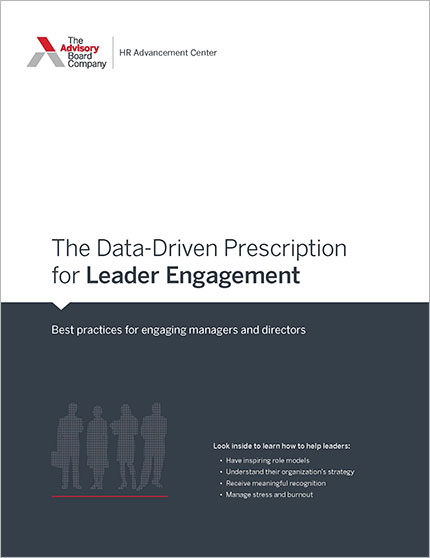Gender disparities among health care leaders plague the industry, but in recent years "bright spots" have emerged in health care and other sectors that show a path forward for health care organizations to increase women's representation in leadership, Lisa Rotenstein, a resident physician at Brigham and Women's Hospital, writes in Harvard Business Review.
Health care is overwhelmingly female—but leadership isn't
While women make up 80% of the health care workforce, "only a small fraction of female physicians become medical leaders," Rotenstein writes. She notes, "Currently in the [United States], only 3% of health care CEOs are women, 6% are department chairs, 9% are division chiefs, and 3% are serving as chief medical officers."
In recent years, leaders in health care and other industries have explored ways to fix this gender disparity, and those efforts "highlight four priority areas" health care organizations can focus on to close the leadership gender gap, Rotenstein writes.
1. Quantify the gender gap
"Before they can make progress, health care organizations need to see how well (or poorly) women are represented among their leadership," Rotenstein writes. Part of this process, according to Rosenstein, is getting a better understanding of female physicians' workplace experiences, and measuring how they compare to their male colleagues.
Further, Rosenstein contends, "Quantification is a key facilitator of change in addressing gender imbalance." She cites the United Kingdom's Athena Swan Charter Awards as a successful quantitative measure of how well organizations support women's advancement. The Charter Awards recognize "commitment to advancement of women in higher education and research." Institutions are awarded bronze, silver, or gold designations for adherence to the requirements. Further, institutions must earn at least a Silver award to qualify for National Institute for Health Research Funding. By quantifying organizations' progress toward gender equity, the charter has initiated structural and cultural changes, increased awareness of gender issues, and established incentives for change, Rotenstein asserts.
2. Standardize awards and broaden promotion opportunities
Recognition within an organization or field can lead to promotions, but female physicians receive major awards and recognitions less often than their male counterparts, Rotenstein writes.
To prevent gender imbalance in promotions, organizations should systematize the way they recognize physician achievements, Rotenstein says. She notes that Brigham and Women's Hospital found that systematic identification of female physicians' accomplishments can reduce the gender gap that affects women early in their careers. Organizations can use similar systematic processes when appointing physicians to committees, nominating physicians for leadership roles, or searching for new physicians.
Another reason women are often overlooked for promotions is because clinical research, a male-dominant field, is favored for promotions in medicine, Rotenstein notes. Female-dominant fields like clinical education and service or less likely to be considered for awards and other forms of recognition. But some organizations, such as Duke University, are making an effort to promote physicians with more diverse career profiles to reduce the gap.
3. Engage men too
Organizations should engage not only women but men was well to improve gender diversity in leadership, according to Rotenstein.
Targeted programs like implicit bias training have been proven to quell discriminatory beliefs and attitudes toward women in medicine, Rotsenstein writes. Dell, for instance, created the Men Advocating Real change program to engage male executive leadership in efforts toward gender diversity and equity by educating male employees on issues of unconscious bias, dominant culture, and gender role conditioning in leadership.
According to Rotenstein, Dell has been able to recruit, retain, and promote more women in male-dominant fields after implementing the program.
4. Create opportunities for development and sponsorship
Women do not have enough sponsorship and career advancement opportunities, Rotenstein writes, which often means female leaders are often "overburdened with mentee requests."
To increase mentorship availability, men and women should be equally engaged in sponsoring qualified women for diverse career opportunities, Rotenstein contends. For example, she notes IBM's Technical Women Pipeline Program pairs mid- and senior-level women with executive advocates for two days to establish career advancement plans. The women check in with their mentees and others in the Pipeline Program quarterly.
Rotenstein reports that the program has resulted in an increase in IBM's retention rates for mid- and senior-level women working in technology (Rotenstein, Harvard Business Review, 10/1).
Advisory Board's take

Veena Lanka, MD, Senior Director
Considering women make up 80% of the healthcare workforce, the number that actually make it into the leadership ranks (3-9%) is woefully inadequate. This gap is simply too large to be attributed to a difference in qualifications alone. We and others have repeatedly raised this question in the last decade. Yet the industry has made few motions, if any, towards improving the workplace experience of female healthcare workers, expanding their career prospects, or recognizing their contributions. Instead, we've let the present-day gender gap—a result of decades of unconscious bias and societal stereotypes—persist.
“We believe this is an issue that deserves to be every hospital leadership team's agenda.”
This is particularly surprising in light of the fact that healthcare industry tends to be ahead of most others (such as financial or legal sectors) in recognizing and addressing gender disparities among the patient communities they serve. While this is commendable, it appears tone-deaf when the gender gap within their own ranks goes unnoticed.
The solutions that are usually offered focus on coaching women to navigate the glass ceiling by leaning in and speaking up. Not only has this failed to make a significant dent in the problem, it inadvertently masks the real issue. It's time for those in positions of influence to shift the burden off the shoulders of the very group marginalized by it.
We believe this is an issue that deserves to be on every hospital leadership team's agenda since it impacts their organization's ability to engage their workforce and achieve just about every system initiative. At minimum, the gender imbalance among leadership influences:
- Retention and recruitment. High-performers are less likely to stay where they perceive a gender-based glass ceiling. This is especially true with high-turnover roles such as nursing, human resources, care navigators, wellness coaches, etc. where over 90% of staff are women.
- Physician engagement. Female physicians report even lower engagement and higher rates of burnout than their male peers. Failing to address their wellbeing is not a viable option as women now also make up majority of the younger physician workforce and the majority of future physicians enrolled in medical school.
- Clinical outcomes. Patients treated by female physicians report higher satisfaction and fare better than those treated by men. Indeed, if men had the same clinical outcomes as women, it could prevent ~32,000 deaths every year. This makes a strong case for keeping more women in the clinical workforce and in leadership roles within that workforce.
- Corporate leadership. Companies with more women in leadership and board positions report 74% more equity and assets, making a strong case for having women in business-facing roles as well.
Concrete ways to address the issue
Healthcare leaders can begin addressing this issue immediately without having to launch yet another standalone campaign (to a highly change-fatigued workforce). Here are concrete ways you can integrate the tactics highlighted by the authors into existing system priorities and initiatives:
- Size the problem at your organization using existing data
- Utilize your human resource data to measure baseline gender ratios for the whole organization, as well as key departments and contrast with ratios of leadership bodies (the board, medical executive committee, clinical consensus groups, etc).
- Segment your annual employee engagement survey results to identify gender-based differences in engagement. If possible, segment this further by clinical/non-clinical roles, tenure, age, facility, and department to identify specific areas with largest gender gap.
- Utilize payroll data to assess gender pay gap and rank-order roles with the largest gaps.
- Educate leaders in positions of authority and influence
- Share the department-specific gender gap data you found with managers, department chiefs, and leaders and encourage them to set 1-2 measurable goals to address these gaps
- Increase transparency of performance criteria and career progression opportunities
- Incorporate trainings addressing unconscious bias, workplace equality, and health disparities into leadership training events, board retreats, new hire training, and annual staff trainings
- Re-evaluate how awardees and nominees are currently chosen
- Review the last five years of existing institutional awards and peer recognition awards to identify if female employees or departments with largely female employees are under-represented
- Assess if award criteria, unconscious bias of selection committee, or the nomination process might be inadvertently excluding female candidates. For instance, you may want to consider replacing management-led nominations with peer-led nominations.
- Build an intentionally inclusive leadership pipeline
- Compile a pipeline of high-performing female employees to be considered for succession planning of leadership roles. Beware of unconscious bias that leads to preferentially screening for your demographic carbon copies
- Utilize turnover on Board, C-suite, and physician leadership groups as opportunities to rebalance ratios
- Pair early-career high performers with mentors of either gender to provide growth opportunities, rather than disproportionately burdening women only to serve as mentors.
Upcoming webconference series: Your guide to building a better workplace culture
Hospitals and health systems have never been more committed to attracting, inspiring and retaining the talent they need. Yet, with limited resources and heightened competition for talent, leaders are increasingly asking what else can be done. In this series, we’ll explore one approach that can help achieve all three objectives—building a differentiated organizational culture.
- Thursday, Nov. 1 | How to embed new norms in your culture
Don't miss out on the latest Advisory Board insights
Create your free account to access 1 resource, including the latest research and webinars.
Want access without creating an account?
You have 1 free members-only resource remaining this month.
1 free members-only resources remaining
1 free members-only resources remaining
You've reached your limit of free insights
Become a member to access all of Advisory Board's resources, events, and experts
Never miss out on the latest innovative health care content tailored to you.
Benefits include:
You've reached your limit of free insights
Become a member to access all of Advisory Board's resources, events, and experts
Never miss out on the latest innovative health care content tailored to you.
Benefits include:
This content is available through your Curated Research partnership with Advisory Board. Click on ‘view this resource’ to read the full piece
Email ask@advisory.com to learn more
Click on ‘Become a Member’ to learn about the benefits of a Full-Access partnership with Advisory Board
Never miss out on the latest innovative health care content tailored to you.
Benefits Include:
This is for members only. Learn more.
Click on ‘Become a Member’ to learn about the benefits of a Full-Access partnership with Advisory Board
Never miss out on the latest innovative health care content tailored to you.

